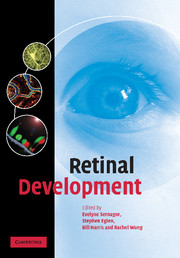Book contents
- Frontmatter
- Contents
- List of contributors
- Foreword
- Preface
- Acknowledgements
- 1 Introduction – from eye field to eyesight
- 2 Formation of the eye field
- 3 Retinal neurogenesis
- 4 Cell migration
- 5 Cell determination
- 6 Neurotransmitters and neurotrophins
- 7 Comparison of development of the primate fovea centralis with peripheral retina
- 8 Optic nerve formation
- 9 Glial cells in the developing retina
- 10 Retinal mosaics
- 11 Programmed cell death
- 12 Dendritic growth
- 13 Synaptogenesis and early neural activity
- 14 Emergence of light responses
- New perspectives
- Index
- Plate section
- References
10 - Retinal mosaics
Published online by Cambridge University Press: 22 August 2009
- Frontmatter
- Contents
- List of contributors
- Foreword
- Preface
- Acknowledgements
- 1 Introduction – from eye field to eyesight
- 2 Formation of the eye field
- 3 Retinal neurogenesis
- 4 Cell migration
- 5 Cell determination
- 6 Neurotransmitters and neurotrophins
- 7 Comparison of development of the primate fovea centralis with peripheral retina
- 8 Optic nerve formation
- 9 Glial cells in the developing retina
- 10 Retinal mosaics
- 11 Programmed cell death
- 12 Dendritic growth
- 13 Synaptogenesis and early neural activity
- 14 Emergence of light responses
- New perspectives
- Index
- Plate section
- References
Summary
Introduction
One of the most striking aspects of the architecture of the retina is its highly organized structure. Retinal neurons are positioned in three different layers, at different depths. Usually, all cells of a particular type are found in just one of those layers. When the spatial distribution of one type of cells within a layer can be observed, the cell bodies are arranged in a semi-regular pattern, rather than distributed randomly across the surface (Figure 10.1). These patterns are often termed ‘retinal mosaics’, due to the way that the cell bodies and dendrites of a type of neuron tend to tile the retina.
This regular arrangement of cells is thought to ensure that the visual field is evenly sampled, avoiding any perceptual blind spots in the visual field. The retina is assembled as an array of functional units, each detecting, processing and conveying to the brain information about a limited portion of the visual scene. The presence of regular arrays of neurons of the same type has long been considered a consequence of this functional design. However, recent studies have shown that retinal mosaics form early in development, before all the elements of the functional units have been born. This chapter reviews our present knowledge of the various mechanisms by which retinal mosaics emerge during development, and summarizes the mathematical techniques used to analyse mosaics.
- Type
- Chapter
- Information
- Retinal Development , pp. 193 - 207Publisher: Cambridge University PressPrint publication year: 2006
References
- 4
- Cited by



